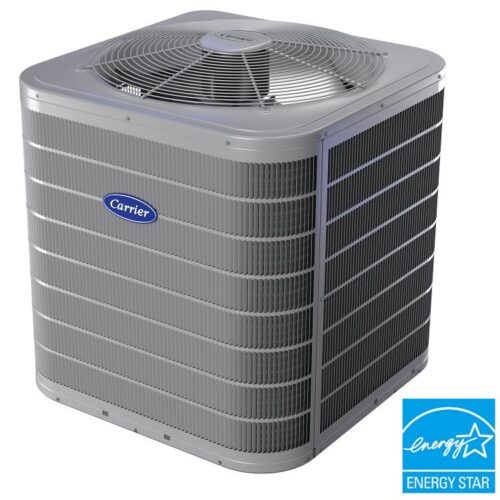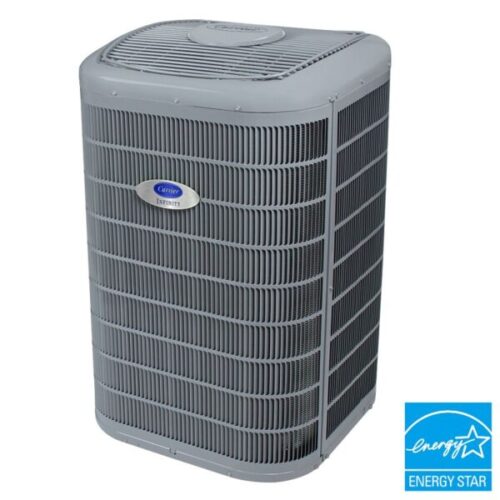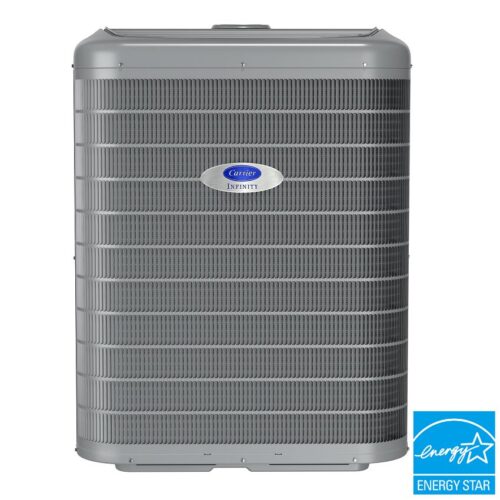Carrier heat pumps prices, and installation costs
Heat pumps provide versatile heating, cooling, and humidity control – they move heat outside your home in the summer and pull heat into your home in the winter. For those in moderate climates, where the temperature doesn’t regularly drop below freezing, a heat pump can be the answer to both heat and cool your home for all your comfort needs. See below Carrier heat pumps prices, and installation costs.
Carrier Comfort Series Heat Pumps
Innovation, efficiency, quality: Carrier Comfort™ Series heat pumps represent years of research and design with one goal in mind – making your family comfortable. With standard models and units designed specifically for the rigors of coastal area installations, Comfort Series heat pumps represent the Carrier quality, environmental stewardship and lasting durability that have endured for more than a century. And, to ensure maximum year-round efficiency with both gas and electric heating capabilities, you can include a new Carrier gas furnace and compatible thermostat to create a Hybrid Heat® dual-fuel system.
-
- Carrier Heat Pumps, Heat Pump
Comfort 15 Carrier 25SCA5 Heat Pump – Up to 15.2 SEER2 and Up to 8.1 HSPF2
- *Fully Installed from: $7,900 – $13,500
- VIEW DETAILS
Carrier Performance Series Heat Pumps
If you could look under the hood of a Carrier Performance Series heat pump, you’d see what drives the performance: a serious commitment to quality. Our two-stage models include innovative extras like our welded aluminum coil technology and a two-speed compressor that together provide benefits like enhanced corrosion resistance, higher efficiency and even, consistent comfort.
-
- Carrier Heat Pumps, Heat Pump
Performance 17 Carrier 25TPA7 Heat Pump – Up to 17 SEER2 and Up to 8.1 HSPF2
- *Fully Installed from: $10,500 – $17,100
- VIEW DETAILS
When installed with a custom-matched Carrier indoor furnace or fan coil and a Carrier Wi-Fi® thermostat, Carrier two-stage heat pumps can operate on low-stage up to 80% of the time to keep airflow and temperatures even and consistent while adding humidity control during cooling operation. As a result, this system can deliver the enhanced comfort and reduced energy use compared to standard systems.
Carrier Infinity Series Heat Pumps
Carrier Infinity System heat pumps represent years of design, development and testing with one goal in mind – maximizing your family’s comfort. Along the way, Carrier have taken the lead in creating new technologies that deliver the outstanding quality and energy efficiency you demand while staying ahead of industry trends and global initiatives.
-
- Carrier Heat Pumps, Heat Pump
Infinity 18VS Carrier 25VNA8 Heat Pump – Up to 18.5 SEER2 and Up to 9 HSPF2
- *Fully Installed from: $10,900 – $17,400
- VIEW DETAILS
-
- Carrier Heat Pumps, Heat Pump
Infinity 24 Carrier 25VNA4 Heat Pump with Greenspeed® Intelligence
- *Fully Installed from: $12,900 – $18,100
- VIEW DETAILS
Breakthroughs like variable-speed technology, enhanced humidity control, smaller cabinet sizes and units designed specifically for the rigors of coastal area installations, mean there’s a model tailored to your needs. And, for year-round efficiency with both gas and electric heating capabilities, ask about Carrier Hybrid Heat® dual-fuel system. Whether you expect maximum energy savings, maximum comfort, minimal sound or all of the above, Carrier Infinity System heat pumps have you covered.
*Price include full Installation for smallest available size unit including all available discounts. A heating/cooling load calculation is necessary to determine the correct size of heat pump to install in the home.
The Average Cost Of A Carrier heat Pump Including Installation Is $7,900 – $18,100
The final price fluctuates based on a number of factors, including the local market, condition of the home and area climate. It also depends upon the type of system. Carrier heat pumps, for example, offer a variety of energy efficiency ratings such as SEER2 and HSPF2, various types of comfort-enhancing technologies and even sound ratings. Installed costs might range from anywhere between $7,900 to $18,100 or more. That’s quite a range! The good news is there are a number of ways to make heat pump installation costs more manageable. These include promotional rebates available during select times of year as well as utility company rebates, financing options, lease-to-own options and/or tax credits.
Federal Tax Credit For Heat Pumps In 2024
Heat pumps are up to four times more efficient than the best gas furnaces, because they essentially redirect cold air from one area to another. The technology is relatively unfamiliar in the US compared to Europe, but is catching on.
The federal tax credit covers up to 30% of qualifying heat pumps purchase and installation labor costs (up to $2,000). This credit applies to new and existing homes and can be claimed in the same tax year as the purchase was made, starting in 2023 and ending in 2032.
What Is a Heat Pump?
Heat pump is part of a home heating and cooling system and is installed outside your home. Like an air conditioner such as central air, it can cool your home, but it’s also capable of providing heat. In cooler months, a heat pump pulls heat from the cold outdoor air and transfers it indoors, and in warmer months, it pulls heat out of indoor air to cool your home. They are powered by electricity and transfer heat using refrigerant to provide comfort all year round. Because they handle both cooling and heating, homeowners may not need to install separate systems to heat their homes. In colder climates, an electric heat strip can be added to the indoor fan coil for additional capabilities. Heat pumps do not burn fossil fuel like furnaces do, making them more environmentally friendly.
- Step 1 – Liquid refrigerant is pumped through an expansion device at the indoor coil, which is functioning as the evaporator. Air from inside the house is blown across the coils, where heat energy is absorbed by the refrigerant. The resulting cool air is blown throughout the home’s ducts. The process of absorbing the heat energy has caused the liquid refrigerant to heat up and evaporate into gas form.
- Step 2 – The gaseous refrigerant now passes through a compressor, which pressurizes the gas. The process of pressurizing the gas causes it to heat up (a physical property of compressed gases). The hot, pressurized refrigerant moves through the system to the coil in the outdoor unit.
- Step 3 – A fan in the outdoor unit moves outside air across the coils, which are serving as condenser coils in cooling mode. Because the air outside the home is cooler than the hot compressed gas refrigerant in the coil, heat is transferred from the refrigerant to the outside air. During this process, the refrigerant condenses back to a liquid state as it cools. The warm liquid refrigerant is pumped through the system to the expansion valve at the indoor units.
- Step 4 – The expansion valve reduces the pressure of the warm liquid refrigerant, which cools it significantly. At this point, the refrigerant is in a cool, liquid state and ready to be pumped back to the evaporator coil in the indoor unit to begin the cycle again.
How a heat pump works? heating mode
A Heat pump in heating mode operates just like cooling mode, except that the flow of refrigerant is reversed by the aptly named reversing valve. The flow reversal means that the heating source becomes the outside air (even when outdoor temperatures are low) and the heat energy is released inside the home. The outside coil now has the function of an evaporator, and the indoor coil now has the role of the condenser. The physics of the process are the same. Heat energy is absorbed in the outdoor unit by cool liquid refrigerant, turning it into cold gas. Pressure is then applied to the cold gas, turning it to hot gas. The hot gas is cooled in the indoor unit by passing air, heating the air and condensing the the gas to warm liquid. The warm liquid is relieved of pressure as it enters the outdoor unit, turning it to cool liquid and renewing the cycle.
Difference Between Heat Pump and Air Conditioner Energy Efficiency
While essentially identical in cooling mode, heating mode is a completely different story. Air conditioners do not provide heating, but heat pumps do. Thanks to a reversing valve in the outdoor unit, a heat pump system works by extracting heat energy from outside air, even in extremely cold temperatures, transferring the heat inside the home, where it releases the heat into the air. A heat pump can heat and cool, but an air conditioner cannot, which is the primary difference between the two HVAC systems. An air conditioner is typically paired with a furnace to provide heat during the cold months. Together, an air conditioner and furnace are a complete heating and cooling system.
Although a heat pump can heat a home, when outside temperatures drop below freezing, the efficiency of a heat pump is affected as the unit requires more energy to maintain warm temperatures inside the home. Typical heat pump systems have an auxiliary electric heater added to the indoor air unit to add supplemental heat when outdoor temperatures drop. However because electric auxiliary heating Is not very efficient, the addition of a furnace can be a solution to this problem, creating a system that relies on the heat pump as the primary heat source but automatically switches to the furnace when appropriate. This Hybrid Heat® technology is both efficient and intelligent.
Heat Pump Installation – free, no-obligation in home estimate
Whether replacing an existing HVAC system for your home, or purchasing one for the first time, there are several important differences to consider when choosing between a heat pump and an air conditioner. Besides choosing the best system for your situation, the size of the unit and its heating/cooling capacity will need to be determined. A proper evaluation of your home’s heating and cooling needs by a trained HVAC professional is the best way to determine the ideal option for you. GSHA Services, LTD your local Carrier HVAC experts are available to help evaluate your situation and help you decide between a heat pump vs AC system. Schedule installation or request a free quote – fill form or call us at 815-322-7007.




